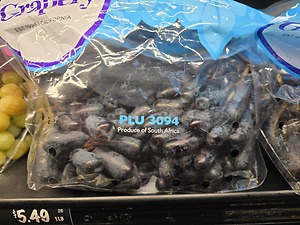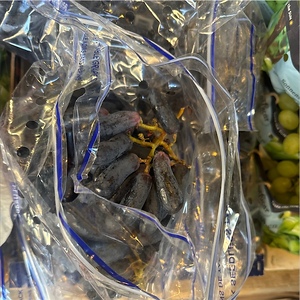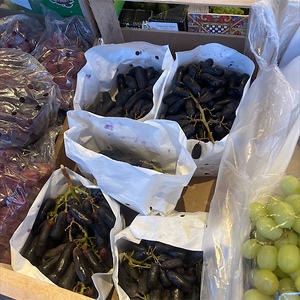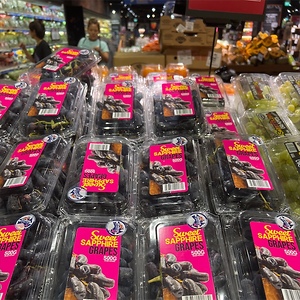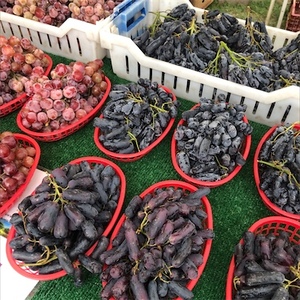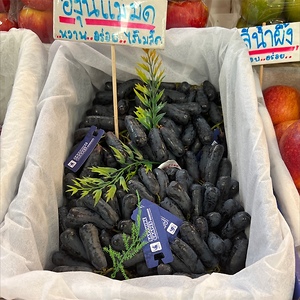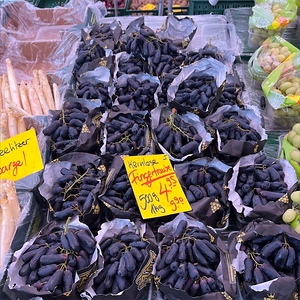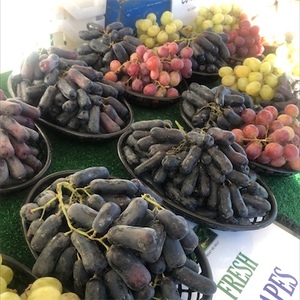

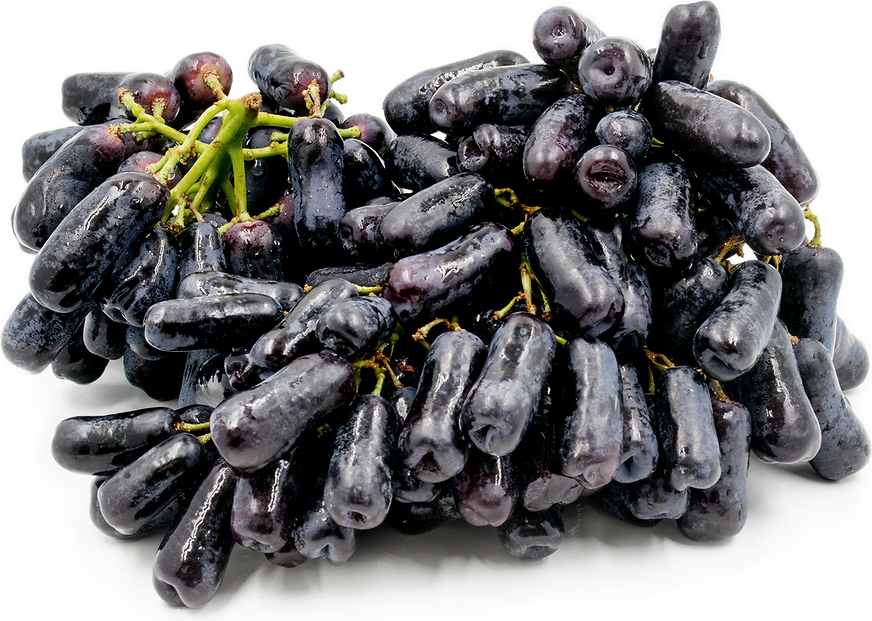
Moon Drop® Grapes
Estimated Inventory, 16 lbs : 0
Description/Taste
Moon Drop® grapes are a medium to large varietal that grows in loose bunches averaging 29 centimeters in length and 16 centimeters in width. Each grape has a distinct, elongated, uniform, and cylindrical shape, about 3 to 4 centimeters in length and 1 to 2 centimeters in diameter, and showcases a characteristic dimple on one end. The grape’s skin is smooth, semi-thick, glossy, and taut. The skin is also dark purple, often appearing black, and is covered in a medium to heavy blue-grey bloom. This bloom is natural and edible but can be easily wiped from the surface if preferred. Underneath the skin, the translucent purple-green flesh is crisp, seedless, and aqueous with a snap-like quality. The grape can actually be broken in two with fingers due to its firm consistency. Moon Drop® grapes are sweeter than standard black grape varieties and contain tannins to create a pleasant and balanced sweet-tart
Seasons/Availability
Moon Drop® grapes are available for a few weeks in the late summer through early fall.
Current Facts
Moon Drop® grapes, botanically classified as Vitis vinifera, are a proprietary variety belonging to the Vitaceae family. The uniquely shaped grapes are a midseason cultivar created to have improved flavors with extended storage and shipping capabilities. Moon Drop® grapes are also known as Sweet Sapphire™ grapes and were created by International Fruit Genetics, a table grape breeding company based in California. The variety is the result of selective breeding techniques and is not genetically modified. Each season, Moon Drop® grapes are covered with plastic to protect the fruit from rain. This allows the grapes to be left in fields for longer periods to develop a sweet, concentrated flavor. Moon Drop® grapes are harvested in stages and are only gathered once they have reached peak maturity. The grapes are only available for a few weeks each year and are sold fresh as a specialty table grape.
Nutritional Value
Moon Drop® grapes have not been studied for their nutritional properties. Like other black grape varieties, the grapes are a source of antioxidants to protect the cells against free radical damage, vitamin A to maintain healthy organ functioning, and vitamin C to strengthen the immune system while reducing inflammation. The grapes also provide vitamin K to assist in faster wound healing, potassium to balance fluid levels within the body, and contain other nutrients, including flavonoids, copper, and manganese.
Applications
Moon Drop® grapes have a sweet-tart flavor suited for fresh and cooked preparations. The grapes are typically consumed straight out of hand and are a popular table grape for their unusual shape. Moon Drop® grapes can also be tossed into salads, mixed into fruit bowls, or skewered onto fruit kabobs. Try chopping the grapes into salsa for a sweet addition or freezing the grapes, consumed as a frozen treat or blended into a slushie. Moon Drop® grapes also make an unusual appetizer, split in half and served with salty cheeses. In addition to fresh preparations, Moon Drop® grapes can be roasted or blistered over high heat, developing a soft texture and sweetness. Cooked grapes complement savory meat dishes, mixed into pasta, topped over ice cream, or spread over toast. The grapes can also be served with Brussels sprouts or bitter greens as a savory-sweet side dish. Moon Drop® grapes pair well with nuts such as pistachios, almonds, pecans, hazelnuts, and walnuts, cheeses including blue, ricotta, goat, and gorgonzola, fruits such as pineapple, berries, melons, and bananas, herbs including rosemary, mint, and fennel, and meats such as pork, poultry, and duck. Whole, unwashed Moon Drop® grapes will keep one week when stored in the refrigerator. They can also be frozen for extended use.
Ethnic/Cultural Info
Moon Drop® grapes were initially known as IFG Six, a name given to the variety when created at International Fruit Genetics. It is important to note that the grape variety is not genetically modified and was created through a process known as “embryo rescue.” This technique allows seed embryos to develop in a cultured medium, typically done to make a seedless cultivar. The seedling is later transplanted into regular soil and is grown using traditional methods, just like other grape cultivars. IFG Six grapes are never altered on the genetic level, and the grape’s coloring and shape were developed from natural breeding practices. At International Fruit Genetics, IFG Six grapes were renamed Sweet Sapphire grapes. Since the grapes were created in partnership with The Grapery®, the variety is also sold under the trademarked name Moon Drops®.
Geography/History
Moon Drop® grapes were created in 2004 by fruit geneticist Dr. David Cain of International Fruit Genetics, also known as IFG, a table grape breeding company in California. The variety was developed from a hand-pollinated cross of an unnamed grape selection C22-121 and Beita Mouni grapes. The product of this cross, patented as IFG Six, was planted in trial fields in 2005 and propagated in fields near Delano, Kern County, in California in 2007. A patent was filed for IFG Six in June 2011 and was granted in April 2013 under US Plant Patent #23531. The variety was trademarked as Moon Drop® grapes before its release in 2004. Today Moon Drop® grapes are grown in the San Joaquin Valley in California and through select retailers in the United States and Canada. The grapes are not cultivated in home gardens as the variety is protected by its patent until at least June 2031.
Recipe Ideas
Recipes that include Moon Drop® Grapes. One
| Adriana's Best Recipes |
|
Halloween Moon Drop Grapes |



